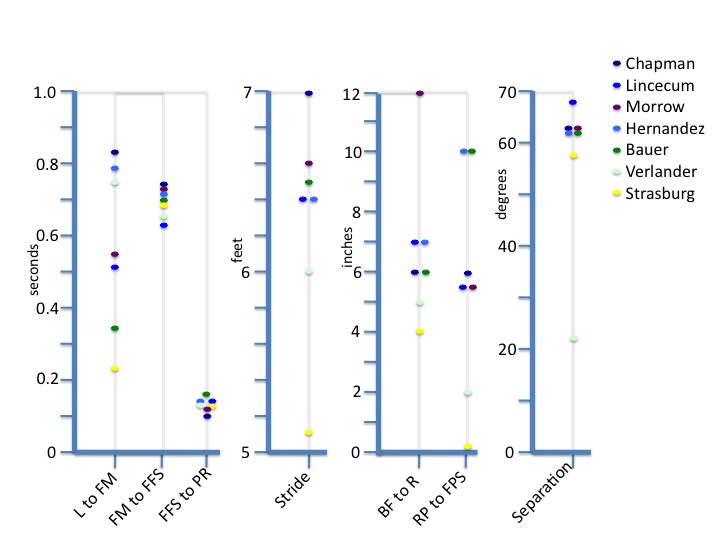 The mechanics of a power pitcher like with Aroldis Chapman, Jason Motte or Tim Lincecum are very similar to the mechanics of Olympic Sprinters like Jeremy Wariner or Usain Bolt. You can learn more about this pitching speed theory in the article, The Phenomenon of Speed Mechanics.
The mechanics of a power pitcher like with Aroldis Chapman, Jason Motte or Tim Lincecum are very similar to the mechanics of Olympic Sprinters like Jeremy Wariner or Usain Bolt. You can learn more about this pitching speed theory in the article, The Phenomenon of Speed Mechanics.
The article talks about the importance of accelerating speed through the pitching delivery to increase pitching velocity. If speed is accelerated through the kinetic chain first as momentum and then converted into rotational forces, there is a strong possibility that a pitcher has reached his top velocity. The article talks about the theory of Speed Mechanics as extremely effective when used with the mechanics of 3X Pitching.
The Speed Mechanics theory is also illustrated in the 3X Pitching Profiles of the 3X Pitchers listed on the forums which is shown in the chart below. These profiles and the chart show that most hard throwing power pitchers have extremely fast deliveries. You will also find on the forums, with the analysis of low velocity pitchers, that they suffer from slow delivery speeds.
3X Pitching Profile Chart

Definitions:
L = Leg Lift = When foot comes off of ground into leg lift.
FFS = Front Foot Strike = When the lift leg lands.
FM = First Move = The moment the hips start moving towards target.
PR = Pitch Release = The moment the ball leaves the hand.
SL = Stride Length = Distance of stride.
RP = Release point = The point of release of pitch.
Sep = Hip to shoulder separation.
FF = Front foot
BF = Back Foot
Important Component of Pitching Speed Mechanics Revealed
A study from the US National Library of Medicine called, Biomechanics of walking, running, and sprinting, reveals an important component of speed mechanics which is also reflective in high velocity pitchers. This component is in the height of an athletes center of gravity when at certain speeds. The center of gravity of an athlete is roughly the hips and core area. Here are the results from the study which measured the difference of mechanics between a group of walkers, runners and sprinter.
As the speed of gait increased, the length of stance phase progressively decreased from 62% for walking to 31% for running and to 22% for sprinting....
Generally speaking, the body lowers its center of gravity with the increased speed by increasing flexion of the hips and knees and magnifying dorsiflexion at the ankle joint. Electromyographic activity about the knee demonstrated increased activity in the quadricep muscle group and hamstring group with increased speed. Muscle function about the ankle joint demonstrated that the posterior calf musculature which normally functions during the midstance phase in walking became a late swing phase muscle and was active through the first 80% of stance phase, as compared to 15% in walking.
This study should be seen as a gold mine to a low velocity pitcher who is looking to increase the speed of his delivery. The reason is that this study has proven that to move quickly, like most hard throwing pitchers do, the athlete most lower his center of gravity. This lowering of the center of gravity will increase the stride length while also activating more muscle function in the legs. This mechanical improvement combined with developing the pitcher into a more explosive athlete, is the 3X approach to pitching velocity and is more proof why this program is so effective.
This study also states that the ankle joint and the muscles of the joint were active through the first 80% of the stride which magnified dorsiflexion in the ankle joint. This would support the importance of an explosive triple extension finishing with the ankle kick to increasing delivery speed which is the foundation of 3X Pitching.
It is important to note that this study is not saying that if you only have a lower center of gravity then you are moving faster, it is only proving that faster movers have lower centers of gravity. This means lowering the center of gravity of the moving athlete will only benefit an explosive athlete who can take advantage of the added muscle function.
A common reaction of a conventional pitching coach who sees a pitcher with a long stride and a lower center of gravity but with poor velocity, is to instruct the pitcher to shorten the stride length. This study would prove this adjustment will only raise the pitchers center of gravity, reducing the pitchers potential to generate speed and velocity and have little or no effect at all on pitching velocity. The better approach for a pitcher who has a low center of gravity and a long stride but poor velocity is to develop more muscle power in a strength and conditioning program that was created for this purpose. This is why pitchers like Tim Lincecum, who have had the same mechanics which included a low center of gravity and a long stride sense he was 8 years old, continued to throw harder the older and more explosive they become.
How to Lower Your Center of Gravity and Increase Pitching Speed
It is great to discover a study like this one which uses science to prove to the pitcher the mechanics of fast athletes but the better discovery is the program that trains the pitcher to implement the motor coordination around this discovery. The 3X Pitching Velocity program is this program. It uses med ball throws and target throws within specific drills of the throwing program to force the pitcher into lowering his center of gravity. It also develops the leg power to allow the pitcher the mobility to move explosively through the pitcher delivery with a lower center of gravity.
This study also proves the importance of looking outside of the sport of baseball for more answers to the questions from inside the game!


Great articles ! ! ! Lowering your center of graity with a longer stride has worked for Connor . Has been consistant ( 80 – 83 ) mph. all yr, , and his control much better . Would like to know how much to increace stride lenght over his ht. ( 6′ 4″ ) to see velocity increace ? Tim Limcome strides over his ht. and has velocity and control with his pitches . Should we experiment or wait till the off-season ?
Wait until the off-season. The key to increasing speeds with a low center of gravity and a long stride is leg power. As you lower the center of gravity the muscle activity increases which puts more demands on the explosive power of the legs.